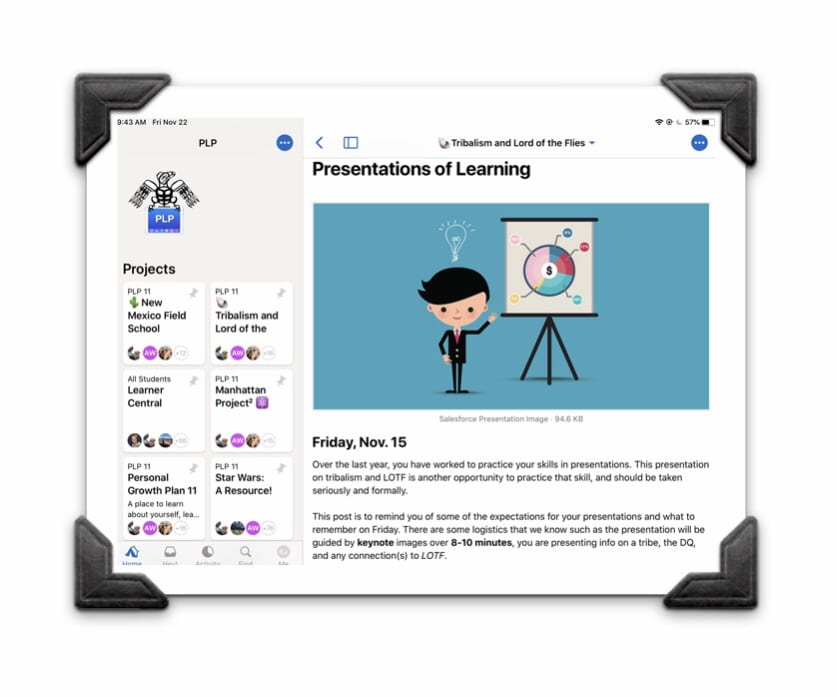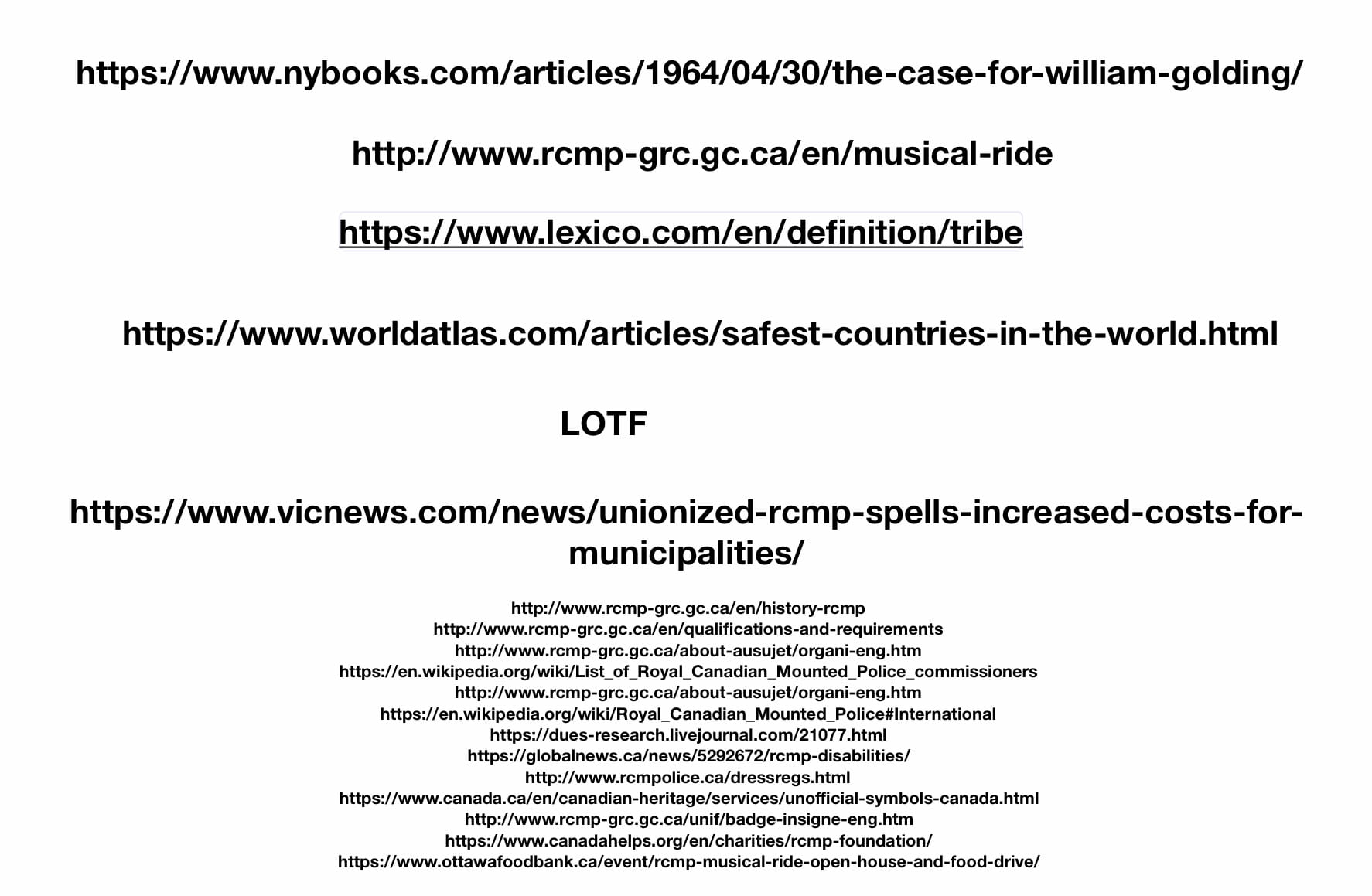In this presentation, Alivia, Logan and I dove into what we think are the three biggest roles of tribalism in society; Identity, Purpose, and Protection. It’s the summative reflection of our exploration of the savagery of pre-pubescent boys, why the RCMP have red serge tunics, and how these two things connect to a PLP class being left alone in a room for 20 minutes. Confused? I sure hope so.
I was confused as well when the teachers told us that our newest unit would be focusing all around our tribes in society. Wait, what do you mean there are tribes in our society? And what do you mean we’re in them? What do they look like? These questions that you’re probably thinking were filling my mind too about a month ago, but unfortunately answering them isn’t that easy. In fact, the only reason I was able to answer them in my presentation is because I’ve completed an entire unit surrounding the topic of tribalism. I’ve discovered incredible literature, explored real life connections, and reflected on my own life, all in hopes of answering our driving question of:


Like all units, we started this one off with looking, listening, and learning. Unlike other units however, we started off by doing all of these things at the exact same time. In order to give the strong foundation of an authentic understanding, we were first tasked in exploring tribalism in our own lives. How the teachers allowed us to do this was by leaving us alone in a room and getting us to form our own teams with no external direction. It was a hard task, but one that taught us valuable lessons not just in teamwork, but in tribalism. This exercise showed some of the crucial things that it can offer:

Of course, at this point we didn’t know what we had learned, because we didn’t actually know what a tribe was. The definition of one was the next thing we were introduced to:

If you’ve followed the launch cycle before, you know that the next step is to ask tons of questions, which was what we did through our Need to Knows discussion:

At this point we had a pretty good idea of where our learning was going to go, and it was time to dive into it. Each day, we were introduced to another form of tribalism that we see in our society, for example sports fandoms or self help groups, and explored media and discussions connected to them. Although it was interesting to learn about the tribes themselves, the biggest benefit of this exploration was that we realized our discoveries from the initial team building exercise applied to almost all tribes. For example, all of them demonstrate value of leadership and there is some sort of common thread or goal bringing everyone in the tribes together.
These explorations happened in and outside of class through a variety of different mediums. Some of the work which came out of this part of the project I’ve linked below:

Through these initial investigations we came to find tribalism a fascinating topic. We aren’t the only ones to feel this way though, as the study of tribes in scientific, literary, and hypothetical contexts has been happening for hundreds of years. A perfect example of this is with the book Lord of the Flies by William Golding. This story explores a darker side of human nature, when a group of school boys trapped on an island go savage and form destructive tribes.
(Click the cover to read the book!)
Not too long nor too short, this book was a perfect 1-monther. Although we were only tasked with reading three or so chapters a week, by the first chapter I was hooked and found myself reading out of pure enjoyment. Later on, I even started reading chapters again to find a plethora of details I missed on the first pass. However, this wasn’t all fun and games; we were reading to prepare for a test. In order to make sure I was ready for it, after our second test I worked to meet my personal goal (which I spoke about in my Manhattan Project Post) of recording both big picture analysis and small details. How I did this was by taking extensive notes, thinking about the book when walking to school, watching external analysis videos and convincing my family to read to book as well and holding discussions at dinner.
Two of my favourite analysis videos
The tests weren’t the only way to show our understanding of this book however, as we were also tasked with writing four response journals (click the picture to read them):
Despite only being around 500 words each, these took extensive time to create. This was because the writing process doesn’t just involve jumping in and writing, but thinking, planning, researching, organizing, and revising.

The first thing I would do after getting a prompt would be to take time and think about my personal ideas. I would ponder them on the way to school, with my friends, with my teachers, and when I found something good I would write it down. The next thing I would do was research in order to assess these ideas with a critical eye, and would continue with them if I could make connections to the real world. Next, I would search for connections to the text within Lord of the Flies, and organize all this into written form. An example of me doing this happens in my journal entry on “What Makes a Great Leader”, when I connected my personal idea of leaders needed to work for others to both Ralph in Lord of the Flies and the real world research example of Malala Yousafzai. At this point however, all I had was an outline. In order to create a creative, informative, and engaging text, I would need to delve into the subtle things to tie everything together. Some of the things I looked at to enhance my messages were:

Now that I had a written product, the final step was make sure all of the spelling and grammar was correct, and create proper citations, both of which I did for every journal. Yes, it was a lot of work, but it was worth it as every response turned out great in my opinion. Doing this taught me so much about how to write in a personal, yet researched and critical way. It also pushed me closer and closer to answering our driving question, as through it I started to notice the themes of identity, protection, and purpose popping up again and again, and solidified them as key ideas.

As I mentioned earlier, all of our Lord of the Flies research was leading up to grand moments where all of our knowledge could be put to the test. In a PLP first, we had graded tests! The first test we had was after three chapters, and had questions ranging from “Who is the main character” to “What little black flying insect is the book named after?”. I’m kidding about that last one, but you get the point that this test was easy. I can’t tell if this was a blessing or a curse however, because none of us were prepared for our second test. It was all around specific quotes and who said them, and I found this to be quite a challenge. After the test, I reflected back on why this was, and came to the conclusion that I wasn’t meeting my goal of balancing details and big picture thinking. This inspired me to work towards doing this in the ways I mentioned earlier for the remainder of the book. I’m glad I followed this path, because I feel the final test went very well. Everything I had learned about tribalism came flooding back to me, and I was able to write critical, personal, and creative responses (*SPOILER* such as how I connected the arrival of the navy captain at the end to the boys realizing the evil in all of man kind portrayed by Golding).
Click the picture to view my test

The test was a great way for us to recall and organize all of our ideas about tribalism, but it was quite messy and on the spot. In order for us to truly bring our thoughts, research, and connections to fruition, we were given one final task, which was the presentation you saw at the beginning of the post. As you also saw, this was a group project, with our groups being the people we had decided on during the initial team exercise. It was also directed with a driving focus, which was to connect research about a real life tribe to Lord of the Flies, and then connect both of these to our driving question.

Our Basecamp Project Post
Shuddering at the memory of the time crunches of Destination Imagination from last year, I was determined to take charge of this project and get the ball rolling. However, this led to more violent shuddering as I then recalled the real issue of last year; my team work struggle. I had been so controlling and focused on our mission that I forgot the needs of our group at times, and this caused a lot of issues. In order to prevent this this time, I decided to lead by example and put my team members before the project. And guess what? It worked! There was no tension, everyone’s ideas got across, and our project turned out really balanced because everyone contributed. A little synergy can go a long way.

This doesn’t mean there wasn’t problems though. Communication was still a massive issue, and although a lot of people did contribute their ideas, I ended up doing the majority of the work as we didn’t have time of discuss with each other what everyone’s roles were. In light of this and reaching success in my teamwork goal, I think my new interpersonal goal is going to be working on communication in the future. I will achieve this by making sure that I am actively listening, that something has been decided by the end of every class, and that everybody is on the same page after every milestone.
I would say the hardest part of this whole project though was trying to connect our variety of messages to all of our points, and then organize it in a way that made sense for our variety of different audiences. This presentation had three different key connection points, and had to educate our classmates who didn’t know about our tribe research, our teacher, and eventually the people reading this blog, and we were only given ten minutes to do so. I kind of compare the process I went through to make everything work like this sliding puzzle below:

If there was a new piece of research we wanted to add, everything else had to be shifted and reconnected to it so that everything flowed. Despite having to write, design, and practice an entire keynote, arranging everything in the outline like this was definitely the hardest and most time consuming part. I was not expecting this however, and we almost missed the presentation due date because of it. In the future, I will consider how important it is to give lots of time for the outlining process.
However, once the challenge was out of the way, all of our hard work payed off and the writing process became easy. I started writing the script with ease and came up with draft one:
After this draft, our group held a discussion to decide what we could improve. It was decided that the script was likely too long, needed more concrete evidence, and should make an attempt to connect more to us personally. We were also given the feedback to improve our citations by putting them into MLA format. I then went back and created a second draft, with Logan making the images and Alivia the MLA sources (and everyone adding edits). This turned out to be our final one:

It started with an experience. Then there were questions. Then research. Then reading, and writing, and presenting. Then, finally, there was a true understanding. From seeing it first hand from the team exercise and through researching tribes in our society, then by bringing this all together to create a final presentation, I was able to learn that tribalism is everywhere. It plays a huge role, like we said in our talk, in the lives of every person on this planet, offering them identity, purpose, protection, and pretty much any other interpersonal benefit you could think of. Whether the people in the tribes are young like the boys in Lord of the Flies or older like we are, tribalism follows us wherever we go. I think it’s pretty obvious that it plays a huge role in our society, because just look at how much the PLP tribe was able to accomplish when we banded together for this unit!


















